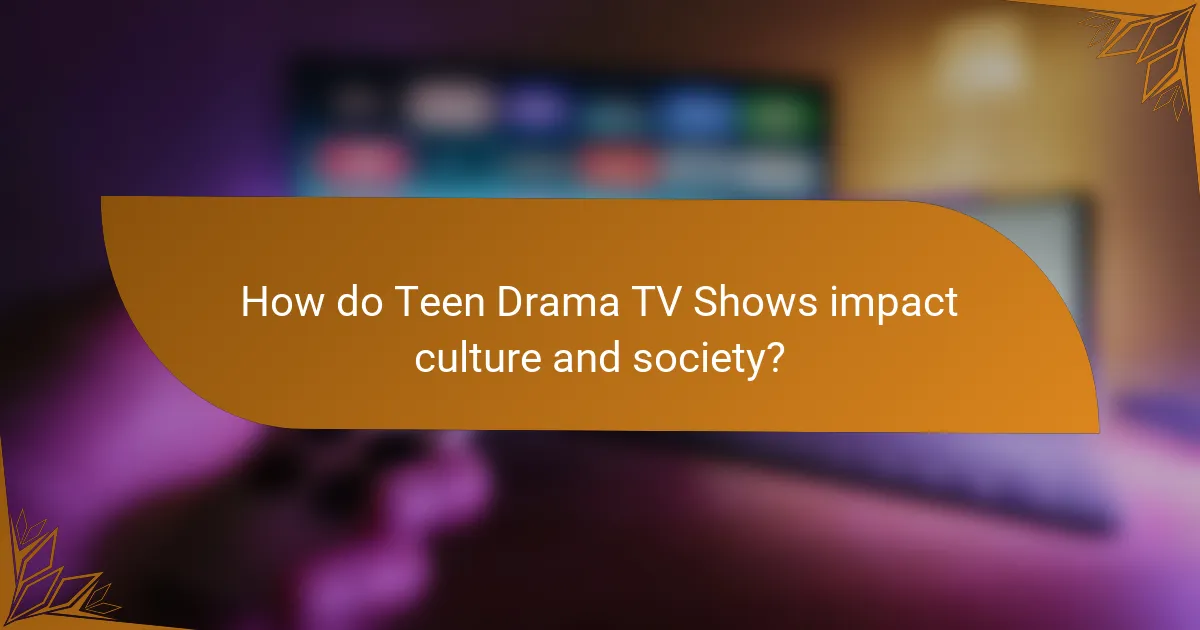Teen drama TV shows are a genre that explores the lives and challenges of adolescents, focusing on themes such as identity, friendship, love, and family dynamics. These shows address relatable issues faced by teenagers, including peer pressure, mental health, and social status, with popular examples like “Dawson’s Creek,” “Gossip Girl,” and “Euphoria.” Key coming-of-age themes include identity exploration, friendship dynamics, and family relationships, which resonate with audiences and reflect real-life experiences. Additionally, teen dramas significantly impact culture and society by shaping youth identity, influencing social norms, and fostering discussions on important topics such as mental health and inclusivity. Overall, these shows serve as both reflections of adolescent life and catalysts for societal change.

What are Teen Drama TV Shows?
Teen drama TV shows are a genre focused on the lives and challenges of adolescents. These shows typically explore themes such as identity, friendship, love, and family dynamics. They often depict relatable issues faced by teenagers, including peer pressure, mental health, and social status. Popular examples include “Dawson’s Creek,” “Gossip Girl,” and “Euphoria.” Teen drama shows have a significant cultural impact, influencing fashion, language, and social trends among youth. They resonate with audiences by providing both entertainment and a reflection of real-life experiences.
How do Teen Drama TV Shows differ from other genres?
Teen drama TV shows differ from other genres by focusing on the experiences and challenges of adolescents. They often explore themes such as identity, relationships, and social issues. Unlike comedies, teen dramas tend to have a more serious tone. They emphasize emotional depth and character development. This genre frequently addresses relatable issues like peer pressure and mental health. Additionally, teen dramas often feature a younger cast compared to other genres. Their narratives are designed to resonate with a teenage audience, making them distinct. This focus on coming-of-age experiences sets them apart from genres like action or horror.
What are the defining characteristics of Teen Drama TV Shows?
Teen drama TV shows are characterized by their focus on adolescent characters and their experiences. These shows often explore themes of identity, relationships, and personal growth. They typically feature relatable issues such as peer pressure, family dynamics, and mental health. The narrative often unfolds in a school setting, which serves as a backdrop for social interactions. Emotional conflicts and dramatic storylines are common, engaging viewers with relatable situations. Additionally, these shows often incorporate diverse perspectives to reflect contemporary society. The portrayal of friendships and romantic relationships is central to the storytelling. Overall, teen dramas aim to resonate with young audiences through authentic and relatable content.
What themes are commonly explored in Teen Drama TV Shows?
Common themes explored in teen drama TV shows include identity, relationships, and social issues. Identity often revolves around self-discovery and the challenges of adolescence. Relationships typically showcase friendships, romantic entanglements, and family dynamics. Social issues frequently address topics like bullying, mental health, and peer pressure. These themes reflect the real-life experiences of teenagers. They resonate with viewers, making the narratives relatable. Teen dramas often depict the struggles and triumphs of growing up. This connection to real-life challenges enhances their cultural significance.
Why are Teen Drama TV Shows important for audiences?
Teen drama TV shows are important for audiences because they address relatable issues faced by teenagers. These shows often explore themes of identity, relationships, and social challenges. They provide a platform for young viewers to see their experiences reflected on screen. This representation can foster a sense of belonging and understanding. Research shows that 70% of teens feel more connected to their peers when they see similar experiences portrayed in media. Additionally, teen dramas can spark conversations about mental health, diversity, and social issues. By engaging with these topics, audiences can develop empathy and awareness. Overall, teen drama TV shows play a crucial role in shaping the cultural landscape for young viewers.
How do these shows reflect real-life adolescent experiences?
Teen drama TV shows reflect real-life adolescent experiences by portraying relatable challenges and emotions. They often depict issues such as identity, peer pressure, and family dynamics. These shows mirror the struggles of navigating friendships and romantic relationships. For example, characters face dilemmas that resonate with viewers, such as bullying or academic stress. Research by the American Psychological Association highlights that media representations can influence adolescent behavior and self-perception. These narratives provide a space for young audiences to see their experiences validated. By addressing topics like mental health and social acceptance, these shows foster dialogue among teens. Overall, they serve as a reflection of the complexities of growing up in today’s society.
What role do Teen Drama TV Shows play in cultural discussions?
Teen drama TV shows play a significant role in cultural discussions by addressing relevant social issues. They often explore themes like identity, relationships, and mental health. These shows reflect the experiences of teenagers, making them relatable to audiences. For instance, series like “Euphoria” tackle topics such as substance abuse and mental health awareness. Additionally, they can influence public opinion and spark conversations about societal norms. By portraying diverse characters, these shows promote inclusivity and representation. Research indicates that such media can impact viewers’ understanding of complex issues. Overall, teen dramas serve as a platform for dialogue on important cultural topics.

What are the key coming-of-age themes in Teen Drama TV Shows?
Key coming-of-age themes in teen drama TV shows include identity exploration, friendship dynamics, and family relationships. Identity exploration often involves characters discovering their values and beliefs. This theme is prevalent in shows like “The Breakfast Club” and “Euphoria.” Friendship dynamics highlight the challenges and growth within peer relationships. Series such as “Friends” and “Riverdale” illustrate this theme effectively. Family relationships emphasize the impact of parental influence and support. Shows like “Gilmore Girls” showcase complex family dynamics. These themes resonate with audiences, reflecting real-life experiences during adolescence.
How do Teen Drama TV Shows portray identity and self-discovery?
Teen drama TV shows portray identity and self-discovery through character development and relatable narratives. These shows often depict adolescents grappling with their sense of self in various social contexts. Characters typically face challenges related to peer pressure, family expectations, and romantic relationships.
For example, shows like “Euphoria” and “The OC” explore themes of mental health and personal growth. They illustrate how characters navigate their identities amidst external influences. Research indicates that viewers often relate to these struggles, which fosters a sense of connection and understanding.
The portrayal of diverse identities, including race, gender, and sexuality, further enriches these narratives. This representation allows for a broader exploration of self-discovery. Overall, teen dramas serve as a mirror reflecting the complexities of adolescent life and identity formation.
What challenges do characters face in their journey of self-discovery?
Characters in their journey of self-discovery face various challenges. These challenges include identity confusion, where characters struggle to understand who they truly are. They often encounter societal pressures that dictate how they should behave. Emotional turmoil is another significant challenge, as characters deal with feelings of anxiety and insecurity. Relationships can complicate self-discovery, leading to conflicts with friends and family. Fear of failure also hinders progress, as characters worry about not meeting expectations. Additionally, characters may confront past traumas that impede their growth. These challenges are commonly depicted in teen drama TV shows, highlighting their relevance in coming-of-age narratives.
How do relationships influence identity development in these shows?
Relationships in teen drama TV shows significantly influence identity development. They shape characters’ self-perception and social roles. Interactions with peers, family, and romantic interests provide critical feedback. This feedback helps characters explore their values and beliefs. For instance, friendships often challenge or reinforce personal choices. Conflicts within relationships can lead to self-discovery and growth. Studies show that social connections are key in adolescent identity formation. According to research by Erikson, relationships during adolescence are pivotal for developing a sense of self.
What issues do Teen Drama TV Shows address that resonate with young audiences?
Teen drama TV shows address various issues that resonate deeply with young audiences. These issues include identity exploration, peer pressure, and mental health challenges. Characters often navigate relationships, both romantic and platonic, reflecting real-life dynamics. Themes of family conflict and acceptance are prevalent, highlighting the struggles of adolescence. Social issues such as bullying, substance abuse, and self-esteem are frequently depicted. The portrayal of diversity and inclusion also resonates, as it reflects the varied experiences of youth today. Overall, these shows mirror the complexities of growing up, making them relatable and impactful for young viewers.
How do these shows tackle topics like mental health and peer pressure?
Teen drama TV shows address mental health and peer pressure through character-driven narratives. They often depict relatable struggles faced by adolescents. These shows frequently illustrate the impact of peer pressure on decision-making. Characters may experience anxiety, depression, or other mental health issues. Storylines often include seeking help from friends or professionals. For example, shows like “13 Reasons Why” highlight the consequences of bullying and mental health crises. They provide a platform for discussing these critical issues openly. Such representations can foster awareness and understanding among viewers.
What role does family dynamics play in the narratives of Teen Drama TV Shows?
Family dynamics are central to the narratives of Teen Drama TV Shows. They often shape character development and influence plotlines. Conflicts within families create tension that drives the story forward. Relationships between parents and teens often highlight generational differences. Sibling rivalries can add complexity to character interactions. Many shows depict family support as crucial for personal growth. For example, “The Fresh Prince of Bel-Air” explores the impact of family structure on identity. In contrast, “Euphoria” addresses the struggles of dysfunctional family relationships. These dynamics reflect real-life challenges faced by teens. Ultimately, family dynamics provide a framework for exploring broader themes of identity and belonging.

How do Teen Drama TV Shows impact culture and society?
Teen drama TV shows significantly impact culture and society by shaping youth identity and influencing social norms. They often portray relatable issues such as relationships, mental health, and peer pressure. These shows provide a platform for discussing topics that resonate with teenagers. For instance, series like “Euphoria” and “13 Reasons Why” have sparked conversations about mental health and suicide prevention. Research by the American Academy of Pediatrics highlights that media portrayals can affect adolescents’ perceptions of risk and behavior. Additionally, these shows often reflect and sometimes challenge societal values, contributing to shifts in cultural attitudes. They can promote inclusivity and diversity, as seen in shows like “[censured] Education,” which addresses various [censured] orientations and identities. Overall, teen dramas serve as both mirrors and catalysts for societal change.
What cultural significance do Teen Drama TV Shows hold?
Teen drama TV shows hold significant cultural value by reflecting and shaping adolescent experiences. They address relatable issues such as identity, relationships, and social challenges. These shows often serve as a mirror to societal norms and expectations faced by teenagers. They provide a platform for discussing topics like mental health, sexuality, and peer pressure. Research indicates that these narratives can influence viewers’ understanding of their own experiences. For instance, a study by the American Psychological Association found that teens identify with characters, which can lead to increased empathy and awareness. Consequently, teen dramas play a crucial role in shaping cultural conversations around youth issues.
How do these shows shape societal perceptions of adolescence?
Teen drama TV shows significantly influence societal perceptions of adolescence. They often portray the challenges and complexities faced by teenagers. These shows depict issues such as identity formation, peer pressure, and mental health. They provide relatable scenarios that resonate with young audiences. Research indicates that viewers often identify with characters, which can validate their own experiences. This identification can lead to increased empathy among peers. Additionally, these shows can challenge stereotypes about adolescence. They contribute to discussions about social issues affecting youth, such as bullying and relationships. Overall, teen dramas shape how society views the adolescent experience, often highlighting both struggles and growth.
What influence do Teen Drama TV Shows have on trends and behaviors among teens?
Teen drama TV shows significantly influence trends and behaviors among teens. They often shape fashion choices, language, and social interactions. For example, popular shows like “Euphoria” and “Riverdale” have led to increased interest in specific clothing styles and beauty trends. Research indicates that teens frequently emulate characters’ behaviors and attitudes, impacting their self-identity and peer relationships. A study published in the Journal of Youth and Adolescence found that exposure to teen dramas correlates with increased discussions about relationships and mental health among viewers. This suggests that these shows provide a platform for teens to explore complex issues, influencing their perspectives and actions in real life.
What are some notable examples of impactful Teen Drama TV Shows?
Notable examples of impactful Teen Drama TV Shows include “The O.C.,” “Friday Night Lights,” and “Euphoria.” “The O.C.” aired from 2003 to 2007 and explored themes of class and family dynamics. It significantly influenced teen culture in the early 2000s. “Friday Night Lights,” which aired from 2006 to 2011, focused on the lives of a high school football team in Texas. It addressed issues such as ambition, community, and personal struggles. “Euphoria,” launched in 2019, delves into the complexities of adolescence, including addiction and identity. Each show has left a lasting impact on viewers and the teen drama genre.
What makes shows like “Euphoria” and “The O.C.” culturally significant?
Shows like “Euphoria” and “The O.C.” are culturally significant due to their exploration of complex adolescent issues. They address themes such as identity, mental health, and social pressures. “Euphoria” portrays the struggles of addiction and trauma, resonating with today’s youth. “The O.C.” highlights class disparities and family dynamics, reflecting societal realities. Both series have sparked conversations about the challenges faced by teenagers. Their impact is evident in how they influence fashion, language, and social media trends. These shows also create a sense of community among viewers, fostering shared experiences. Their storytelling approaches have redefined the teen drama genre, making them culturally relevant.
How have these shows evolved over time to reflect changing societal norms?
Teen drama TV shows have evolved significantly to reflect changing societal norms. Initially, these shows focused on simplistic portrayals of teenage life. Early examples often emphasized traditional gender roles and limited diversity. Over time, they began to include more complex characters and diverse storylines. Modern teen dramas address issues like mental health, sexuality, and social justice. Shows like “Euphoria” and “13 Reasons Why” illustrate this shift by tackling real-life challenges faced by youth today. This evolution mirrors broader societal changes, such as increased awareness of mental health and [censured] rights. The portrayal of diverse backgrounds and experiences has become more prevalent, promoting inclusivity. Consequently, teen dramas now serve as a platform for discussing critical societal issues.
What tips can help viewers navigate the themes in Teen Drama TV Shows?
Viewers can navigate the themes in Teen Drama TV Shows by identifying key character arcs. Understanding character development helps viewers relate to the challenges faced. Recognizing common themes such as friendship, love, and self-discovery enhances viewing experience. Engaging with online discussions can provide additional insights into complex narratives. Analyzing plot structures reveals how conflicts are resolved. Keeping a journal of thoughts while watching can clarify personal reactions to themes. Researching the cultural context of the show can deepen understanding of its messages. Finally, watching with a critical eye allows for a more nuanced appreciation of the storytelling.
How can one critically engage with the messages in these shows?
One can critically engage with the messages in teen drama TV shows by analyzing character development and story arcs. Observing how characters evolve reveals underlying themes and societal issues. Additionally, viewers should assess the portrayal of relationships and conflicts. This assessment can highlight cultural norms and expectations. Comparing the show’s messages to real-life scenarios fosters deeper understanding. Engaging with audience reactions and critiques also provides valuable insights. Research shows that critical viewing enhances media literacy among adolescents. Studies indicate that this engagement can lead to more informed discussions about identity and social issues.
What should viewers consider when discussing the issues presented in Teen Drama TV Shows?
Viewers should consider the portrayal of real-life issues in Teen Drama TV Shows. These shows often address themes like identity, relationships, and mental health. Understanding the context behind these themes is crucial. Viewers should recognize that the characters’ experiences reflect broader societal issues. This can foster empathy and critical discussion. Additionally, cultural representations in these shows can influence perceptions. Viewers must also consider the target audience’s age and maturity. This helps in understanding the appropriateness of certain content. Engaging with these shows thoughtfully can lead to meaningful conversations about youth experiences.
Teen drama TV shows are a genre that focuses on the lives and challenges of adolescents, exploring themes such as identity, relationships, and social issues. These shows often depict relatable issues like peer pressure and mental health, resonating with young audiences and fostering a sense of belonging. The article discusses the defining characteristics of this genre, its cultural significance, and the impact it has on societal perceptions of adolescence. Additionally, it highlights key coming-of-age themes and notable examples of impactful teen dramas, illustrating how these narratives reflect real-life experiences and contribute to important cultural discussions.


